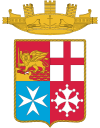Italian Navy
This article needs additional citations for verification. (January 2013) |
| Italian Navy | |
|---|---|
| Marina Militare | |
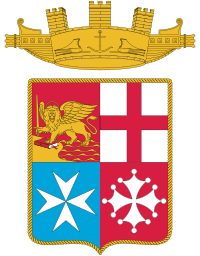 The coat of arms of the Italian Navy, composed of four coats of arms of former Italian maritime republics (clockwise from top left: Venice, Genoa, Pisa and Amalfi) | |
| Founded | 1861 as Regia Marina (official) 1946 as Marina Militare |
| Country | |
| Type | Navy |
| Role | Naval warfare |
| Size | 30,923 personnel 184 vessels (incl. minor auxiliaries) 70 aircraft[1] |
| Motto(s) | Italian: Patria e Onore "Fatherland and Honour" |
| March | La Ritirata (ritirata is the return of soldiers to their barrack, or sailors to their ship after a leave) by Tommaso Mario |
| Anniversaries | 10 June – Sinking of the Austro-Hungarian battleship SMS Szent István by Luigi Rizzo |
| Decorations | 1 Cavalier Cross of the Military Order of Savoy 3 Cavalier's Crosses of the Military Order of Italy 2 Gold Medals of Military Valor 1 Silver Medal of Military Valor 1 |
| Commanders | |
| capo di stato maggiore della marina (Chief of Staff of the Italian Navy) | ammiraglio di squadra Giuseppe Cavo Dragone |
| sottocapo di stato maggiore della marina Deputy Chief of Naval Staff | ammiraglio di squadra Claudio Gaudiosi |
| Insignia | |
| Roundels |   |
| Ensign | 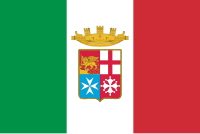 |
| Jack |  |
The Italian Navy (Italian: Marina Militare, lit. 'Military Navy'; abbreviated as MM) is the navy of the Italian Republic. It is one of the four branches of Italian Armed Forces and was formed in 1946 from what remained of the Regia Marina (Royal Navy) after World War II. As of August 2014, the Italian Navy had a strength of 30,923 active personnel, with approximately 184 vessels in service, including minor auxiliary vessels. It is considered a multiregional and a blue-water navy.[2][3][4]
History[]
Before and during World War II[]
The Regia Marina was formed on 17 March 1861, after the proclamation of the Kingdom of Italy.[5] The Italian Navy assumed its present name after the Italian monarchy was abolished following a popular referendum held on 2 June 1946.
After World War II[]
At the end of its five years involvement in World War II, Italy was a devastated nation. After the end of hostilities, the Regia Marina – which at the beginning of the war was the fourth largest navy in the world, with a mix of modernised and new battleships – started a long and complex rebuilding process. The important combat contributions of the Italian naval forces after the signing of the armistice with the Allies on 8 September 1943, and the subsequent cooperation agreement on 23 September 1943, left the Regia Marina in a poor condition, with much of its infrastructure and bases unusable and its ports mined and blocked by sunken ships. However, a large number of its naval units had survived the war, albeit in a low efficiency state, which was due to the conflict and the age of many vessels. The vessels that remained were:
- 5 battleships
- 10 cruisers
- 10 destroyers
- 20 frigates
- 20 corvettes
- 50 fast coastal patrol units
- 50 minesweepers
- 19 amphibious operations vessels
- 5 school ships
- 1 support ship and plane transport
The peace treaty[]
The peace treaty signed on 10 February 1947 in Paris was onerous for Regia Marina. Apart from territorial and material losses, also the following restrictions were imposed:
- A ban on owning, building or experimenting with atomic weapons, self-propulsion projectiles or relative launchers, etc.
- A ban on owning battleships, aircraft carriers, submarines and amphibious assault units.
- A ban on operating military installations on the islands of Pantelleria, Pianosa and on the archipelago of the Pelagie Islands.

The treaty also ordered Italy to put the following ships at the disposals of the victorious nations United States, Soviet Union, Great Britain, France, Greece, Yugoslavia and Albania as war compensation:
- 3 battleships: Giulio Cesare, Italia, Vittorio Veneto;
- 5 cruisers: Emanuele Filiberto Duca d'Aosta, Attilio Regolo, Scipione Africano, Eugenio di Savoia and Eritrea;
- 7 destroyers, 5 of the Soldati class and Augusto Riboty and Alfredo Oriani;
- 6 minesweepers: like Aliseo and Fortunale;
- 8 submarines: 3 of the Acciaio class;
- 1 sailing school ship: Cristoforo Colombo.
The entry into NATO[]
This section does not cite any sources. (March 2017) |
Great changes in the international political situation, which were developing into the Cold War, convinced the United Kingdom and United States to discontinue the transfer of Italy's capital ships as war reparations. Some had already been dismantled in La Spezia between 1948 and 1955, including the aircraft carrier Aquila. However, the Soviet Union demanded the surrender of the battleship Giulio Cesare and other naval units designated for transfer. The cruisers Attilio Regolo and Scipione Africano became the French Chateaurenault and Guichen, while Eugenio di Savoia became the Greek Elli. After break up and/or transfers, only a small part of the fleet remained to be recommissioned into the Marina. As Western attention turned to the Soviets and the Mediterranean Sea, Italian seas became one of the main sites of confrontation between the two superpowers, contributing to the re-emergence of Italy's naval importance thanks to her strategic geographical position.

With the new elections in 1946, the Kingdom of Italy became a republic, and the Regia Marina took the name of Marina Militare (lit. 'Military Navy'). As the Marshall Plan began to rebuild Italy and Europe was rapidly being divided into two geopolitically antagonistic blocs, Italy began talks with the United States to guarantee adequate security considerations. The US government in Washington wished to keep its own installations on the Italian Peninsula and relaxed the Treaty restrictions by including Italy in the Mutual Defense Assistance Programme (MDAP). On 4 April 1949, Italy joined the North Atlantic Treaty Organisation (NATO) and, in order for the navy to contribute actively in the organization, the Treaty restrictions were definitively repealed by the end of 1951, with the consent of all of Western nations.
Within NATO, the Italian Navy was assigned combat control of the Adriatic Sea and Strait of Otranto, as well as the defence of the naval routes through the Tyrrhenian Sea. To ensure these tasks a Studio sul potenziamento della Marina italiana in relazione al Patto Atlantico (Study on the development of the Italian Navy with reference to the Atlantic Pact) was undertaken, which researched the structures and the methods for the development of the navy.
[]
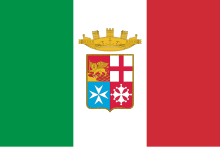
The ensign of the Italian Navy is the flag of Italy bearing the coat of arms of the Italian Navy. The shield's quarters refer to the four Medieval Italian Maritime Republics:
- 1st quarter: on red, a golden winged lion (the lion of St. Mark) wielding a sword (Republic of Venice)
- 2nd quarter: on white field, red cross (Republic of Genoa)
- 3rd quarter: on blue field, white Maltese cross (Republic of Amalfi)
- 4th quarter: on red field, white Pisan cross (Republic of Pisa)
The coat of arms is surmounted by a golden crown, which distinguishes military vessels from those of the merchant navy.
The crown, corona rostrata, was proposed in 1939 as a conjectural link to the Roman navy by Admiral Domenico Cavagnari, then a member of the Chamber of Fasces and Corporations in the Fascist government. In the proposal, Adm. Cavagnari wrote that "in order to recall the common origin [of the Navy] from the Roman mariners, the Insignia will be surmounted by the towered Crown with rostra, the emblem of honour and valour the Roman Senate awarded to the leaders of naval victories, conquerors of lands and cities across the seas".
A further difference is that St. Mark's lion, symbolising the Republic of Venice, does not hold the gospel in its paw (as it does on the civil ensign, where the book is open at the words "Pax tibi Marce, evangelista meus", meaning "peace to you, Mark, my evangelist") and is wielding a sword instead: such an image is consistent with the pictorial tradition from Venetian history, in which the book is shown open during peacetime and closed during wartime.
Structure and organisation[]
Organization[]
In 2012 the Navy began a restructuring process that will see a 21% decrease in personnel by 2025. A new structure was implemented in January 2014.[6]
| Position | Italian title | Rank | Incumbent |
|---|---|---|---|
| Chief of Staff of the Navy | Capo di Stato Maggiore della Marina | Admiral | Giuseppe Cavo Dragone |
| Deputy Chief of Staff of the Navy | Sottocapo di Stato Maggiore della Marina | Vice Admiral | [7] |
| Commander in Chief Naval Fleet | Comandante in Capo della Squadra Navale (CINCNAV) | Vice Admiral | Enrico Credendino[8] |
| Commander Schools Command | Comandante Scuole (MARICOMSCUOLE) | Vice Admiral | ?[9] |
| Commander Logistics Command | Comandante Logistico (MARICOMLOG) | Vice Admiral | Eduardo Serra[10] |
|
Comandante del Comando Marittimo Nord (MARINANORD) | Rear Admiral | Giorgio Lazio[11] |
|
Comandante del Comando Marittimo Sud (MARINASUD) | Rear Admiral | Eduardo Serra[12][13] |
|
Comandante del Comando Marittimo Sicilia (MARISICILIA) | Rear Admiral | [14] |
|
Comandante del Comando Marittimo Capitale (MARICAPITALE) | Rear Admiral | |
| Raiders and Divers Grouping | Comandante Raggruppamento Subacquei ed Incursori (COMSUBIN) | Rear Admiral | Paolo Pezzuti |
Coast Guard[]
The Corps of the Port Captaincies – Coast Guard (Corpo delle Capitanerie di porto – Guardia costiera) is the coast guard of Italy and is part of the Italian Navy under the control of the Ministry of Infrastructures and Transports. In Italy, it is commonly known as simply the Guardia costiera. The Coast Guard has approximately 11 000 staff. [15]
Corps[]
The Italian Navy is divided into seven corps (by precedence) and one:
- Corpo di stato maggiore – Staff Officers Corps (SM): line officers
- Corpo del genio navale – Navy Engineers Corps (GN)
- Corpo sanitario militare marittimo – Maritime Military Medical Corps: (MD) for medics, (FM) for pharmacists
- Corpo di commissariato militare marittimo – Military Maritime Commissariat Corps (CM): administration
- Corpo delle capitanerie di porto – Port Captaincies Corps (CP): the coast guard
- Corpo degli equipaggi militari marittimi – Military Maritime Crews Corps (CEMM)
Fleet[]
Command of the Italian Fleet (ships, submarines and amphibious forces) and Naval aviation[16] falls under the Commander in Chief Naval Fleet.
Equipment[]
Ships and submarines[]
Today's Italian Navy is a modern navy with ships of every type. The fleet is in continuous evolution, and as of today oceangoing fleet units include: 2 light aircraft carriers, 3 amphibious assault ships, 4 destroyers, 13 frigates and 8 attack submarines. Patrol and littoral warfare units include: 10 offshore patrol vessels. 10 mine countermeasure vessels, four coastal patrol boats, and a varied fleet of auxiliary ships are also in service.[17]
The flagship of the fleet is the carrier Cavour.
Aircraft[]
The Italian Navy operates a diverse fleet of aircraft including fixed-wing, rotary and UAVs.

AV-8B Harrier II
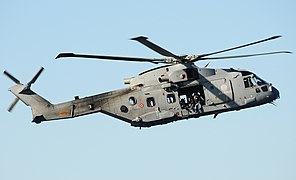
EH-101-410 Merlin
Future[]
- 2 x Bergamini-class general purpose (Enhanced, with ASW capabilities) frigates, being built to replace two vessels from the Italian FREMM-class build program that were transferred to Egypt in 2020 and 2021; delivery is anticipated in the 2025-26.[18]
The 2014 Naval Act allocated Euro 5.4 billion for the following vessels:[19]
- 1 x Trieste landing helicopter dock (L9890), for commissioning in 2022 (with 4 landing craft Vittoria LC23 and 2 combat boat Baglietto MNI15) to replace CVL Giuseppe Garibaldi (551)
- 7 x Thaon di Revel-class offshore patrol vessels, for commissioning between 2021 and 2026, with three more on option[20]
The 2017 budget allocated 12.8 billion (2017–2032 years) for the following ships:
- 1 x Special & Diving Operations - Submarine Rescue Ship (SOD - SuRS),[21] to replace the submarine rescue ship Anteo (A 5309)
- 1 x Major Hydro-oceanographic Ship (NIOM),[22] to replace the hydrographic survey vessel Ammiraglio Magnaghi (A5303)
- 12 x minehunters to replace the Lerici and Gaeta-class minehunters:[20]
- 8 x Cacciamine Nuova Generazione-Costieri (CNG-C, New Generation Minehunter – Coastal) for homeland security roles (about 800 t and 57 m)
- 4 x Cacciamine Nuova Generazione-Altura (CNG-A, New Generation Minehunter – Ocean-going) for expeditionary roles (about 1,300 t and 75–80 m)
- 8 x European Patrol Corvettes in a joint program with France (about 3,200 t)[20]
The 2018 budget allocated about 1 Billion Euros for:[23]
- 2 x U212NFS attack submarines, for commissioning in 2027–2029, with two more on option to maintain a fleet of eight submarines[24]
The "Documento Programmatico Pluriennale 2021-2023" funds follows ships [25]:
- 2 x 11,000-ton DDX-class destroyers, development of the Horizon-class, to replace the Durand de la Penne-class guided missile destroyers by 2027[20][26]
- 2 x Vulcano-class logistic support ships, to replace Vesuvio (A5329) and Etna (A 5326)[20]
- 1 x UBOS, diving support vessel
- 10 x MTC, coastal transport vessel to replace 11 MTC/MTF "Gorgona" class
- 4 x training vessel
- MLU Mid-Life Update Horizon-class
- Planned
- 3 x amphibious transport docks, to replace the San Giorgio-class amphibious transport docks (about 18,000 t)[20]
- 1 x electronic surveillance ship to add to the existing Elettra (A 5340)[20]
- 1 x submarine and minehunter support ship[20]
For the Naval Aviation the Navy plans to expand for replace the following assets:[20]
- 9 x maritime patrol aircraft (currently 4 x ATR 72MP in service)
- 30 x heavy helicopters (currently 22 x AW101 in service)
- 12 x light utility helicopters, a new acquisition of AW169 helicopters
- 16 x tactical unmanned aerial vehicles (currently 10 x ScanEagle in service)
For the San Marco Marine Brigade, the Navy plans to acquire following assets:[20]
- 72 x ACV 1.1 amphibious 8x8 combat vehicles
- 90 x VTMM Orso armored 4x4 vehicles
Rank structure[]
| Italian Navy ranks hierarchy | |||||||||||||||
|---|---|---|---|---|---|---|---|---|---|---|---|---|---|---|---|
| Category | Admirals | Senior officers | Junior officers | Naval cadets OF(D) | |||||||||||
| NATO Code | OF-10 | OF-9 | OF-8 | OF-7 | OF-6 | OF-5 | OF-4 | OF-3 | OF-2 | Subaltern officers OF-1 | |||||
| summer uniform (epaulette) |

|

|

|

|

|

|

|

|

|

|

|

|

|

| |
winter uniform (cuff) |

|

|

|

|

|

|

|

|

|

|

|

|

|

| |
| Italian rank name |
ammiraglio di squadra1 | ammiraglio di squadra con incarichi speciali (i.s.)2 |
ammiraglio di squadra |
ammiraglio ispettore comandante di corpo |
ammiraglio di divisione |
contrammiraglio |
capitano di vascello |
capitano di fregata |
capitano di corvetta |
primo tenente di vascello |
tenente di vascello |
sottotenente di vascello |
guardiamarina | aspirante guardiamarina3 | |
| English rank name translation | Admiral | Admiral (s.a.) | Vice Admiral | Admiral Inspector Chief of Corps |
Rear Admiral Upper Half | Rear Admiral Lower Half | Captain | Commander | Lieutenant Commander | First Lieutenant | Lieutenant | Lieutenant Junior Grade | Ensign | Acting Ensign | |
|
Notes: 2 The rank of ammiraglio di squadra con incarichi speciali (squadron admiral with special assignments) is assigned to the naval officer promoted as chief of the naval staff and/or as secretary of defense. 3 As Officer Designated, the rank of aspirante guardiamarina is comparable to the Royal Navy midshipman. | |||||||||||||||
See also[]
References[]
- ^ "LA MARINA MILITARE OGGI" (PDF). www.marina.difesa.it (in Italian).
- ^ Todd, Daniel; Lindberg, Michael (May 14, 1996). Navies and Shipbuilding Industries: The Strained Symbiosis. Greenwood Publishing Group. ISBN 9780275953102. Retrieved May 14, 2018 – via Google Books.
- ^ Till, Geoffrey (August 2, 2004). Seapower: A Guide for the Twenty-First Century. London: Routledge. pp. 113–120. ISBN 9781135756789. Retrieved December 15, 2015.
- ^ Coffey, Joseph I. (1989). The Atlantic Alliance and the Middle East. United States: University of Pittsburgh Press. p. 89. ISBN 9780822911548. Retrieved November 30, 2015.
- ^ "151° anniversario della Marina Militare all'insegna della solidarietà e della sobrietà" (in Italian). Ministero della Difesa Marina Militare. June 6, 2012. Retrieved May 28, 2020.
- ^ https://www.mise.gov.it/images/stories/trasparenza/2019/cv/CV-ITA-De-Carolis-SCSMM-OTT-2019.pdf
- ^ "Commander in Chief Naval Fleet - Marina Militare".
- ^ "Il Comandante delle Scuole - Marina Militare".
- ^ "Comandante del Comando Logistico della Marina Militare - Marina Militare".
- ^ "Il Comandante - Marina Militare". marina.difesa.it. Retrieved May 14, 2018.
- ^ "Comandante del Comando Marittimo Sud - Marina Militare". marina.difesa.it. Retrieved May 14, 2018.
- ^ "Marina Militare, cambio al vertice Le foto". tarantobuonasera.it. Retrieved May 14, 2018.
- ^ "Archived copy". Archived from the original on June 27, 2015. Retrieved January 19, 2017.CS1 maint: archived copy as title (link)
- ^ "Coast Guard – Port Authorities". Italian Navy. Retrieved September 6, 2016.
- ^ "The Present Aviation - Marina Militare". marina.difesa.it. Retrieved May 14, 2018.
- ^ "The Fleet - Marina Militare". marina.difesa.it. Retrieved May 14, 2018.
- ^ "New ships, submarines and weapon systems for Italian Navy". November 23, 2020.
- ^ "Naval Program 2014 - Marina Militare". marina.difesa.it. Retrieved May 14, 2018.
- ^ Jump up to: a b c d e f g h i j "Linee di indirizzo strategico 2019-2034" (PDF). Marina Militare. Stato Maggiore della Marina. Retrieved November 11, 2019.
- ^ "Fincantieri - Logistic Support Ships". fincantieri.com. Retrieved May 14, 2018.
- ^ "Fincantieri - Hydrographic Survey Vessel". fincantieri.com. Retrieved May 14, 2018.
- ^ "Pinotti: "L'Italia avrà altri due sommergibili" - The Medi Telegraph". themeditelegraph.com. Retrieved May 14, 2018.
- ^ "Italy's U212NFS Near Future Submarine Contract Signed". February 26, 2021.
- ^ https://www.forzearmate.org/difesa-approvato-il-documento-programmatico-pluriennale-2021-2023/
- ^ "New ships, submarines and weapon systems for Italian Navy". November 23, 2020.
External links[]
| Wikimedia Commons has media related to Marina Militare. |
- Italian Navy
- Marina Militare
- 1946 establishments in Italy






